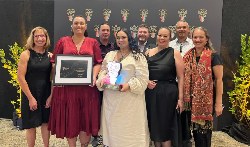Forty Years Since Talkback Was Born In Masterton
The Rt Hon Jonathan Hunt will launch a new history of New Zealand broadcasting at Parliament Buildings tomorrow, 4 October 2000. 'Voice and Vision' will conclude Patrick Day's history of New Zealand broadcasting.
'Voice and Vision' will be launched 40 years to the day since talkback radio was born in New Zealand.
On 4 October 1965, after a two-month trial with Jessica Weddell at 2XB Masterton, all commercial radio stations renamed their women's programmes 'Person to Person', added an extra half-hour and included a talkback segment.
Dr Day says initial fears that New Zealanders were too inhibited to make talkback a success proved unfounded.
"Any reticence came from the corporation, which greatly restricted the range of acceptable topics, and from announcers who, unlike many of their later counterparts, preferred to draw out opinions from listeners rather than lead discussion with their own views", he says.
Dr Day notes this early format did not survive the introduction of afternoon television in 1967. Commercial radio's chances of competing with television were further reduced from June of that year with the start of 'On Camera', an on-screen equivalent to 'Person to Person'.
The talkback format was revived in the early '70s by the new private radio stations. Dr Day says that along with their popular music format, the reintroduction of talkback proved highly successful in enticing listeners back to radio.
Talkback revived on Radio i with the opinionated Eccles Smith and was soon followed elsewhere. The formats varied considerably. Some hosts such as Gordon Dryden on Radio i and Brian Edwards on Radio Windy ran three-hour programmes of almost solid talk. Others, such as Paddy O'Donnell of 2ZB, blended talkback with news, music and other entertainment. Radio Windy's Erich Geiringer held an audience for a regular show on purely medical topics.
The best talkback hosts such as Gordon Dryden were highly popular and the Radio i audience more than doubled when his show began.
In contrast to earlier experiences with talkback radio programmes, the hosts in the '70s were given remarkable freedom. For example, Geoff Sinclair was chosen as a Radio i host because of his different opinions and approach. Tim Bickerstaff, the knowledgeable, abrasive host of 'Sportsline' on Radio i, apparently had no problem advocating a 'Punch a Pom a Day' campaign after All Black Keith Murdoch was dismissed from the 1972-73 tour of Britain.
Dr Day says that although talkback radio remained under station control - the hosts chose the topics and could always silence a caller - it now constituted a major new use of the medium, which quickly became an accepted way of forming and expressing public opinion.
Many politicians kept tuned to their local talkback station, ready to phone in their own views. Several, before, after and even during their terms in office, became talkback hosts, adding a new dimension to the long political tradition of media involvement through writing regular newspaper columns.
'Voice and Vision' follows 'The Radio Years' (1994) and is the second and concluding volume of Patrick Day's history of New Zealand broadcasting.
Dealing with the years from 1950 to the present, 'Voice and Vision' charts the shift from state to public broadcasting, the birth of television and the spread of coverage nationwide.
It follows the many changes in the structure of broadcasting, from the NZBC through to the 1990s focus on broadcasting as essentially commercial activities. Public and private broadcasting in both media are covered in depth and Dr Day shows how private radio and television gained new acceptance as they rose to dominance in the 1990s alongside the growing commercialisation of public broadcasting.
'Voice and Vision: A History of New Zealand Broadcasting Volume Two' Patrick Day 468p, hardback, ISBN 1 86940 233 2, $59.95
- ENDS -
Christine O'Brien Marketing Manager Auckland University Press http://www.auckland.ac.nz/aup
Tel: (64-9) 373-7999 x 5735 Fax: (64-9) 373-7465 -------------------------------------------- New titles from AUP:
"Voice and Vision: A History of New Zealand Broadcasting Volume 2" Patrick Day (Broadcasting has played a significant role in forming our ideas of identity and nation. Pat Day concludes his history of NZ broadcasting with full coverage of developments from 1950 to the present day. 1 86940 233 2; $59.95. Two-volume set: 1 86940 241 3; $99)
**Reprinting** "His Way: A Biography of Robert Muldoon" Barry Gustafson ("There is no doubt about who is our number one political biographer" - Michael King. 1 86940 236 7; $59.95) --------------------------------------------


 Environmental Defence Society: Groundhog Day, New Book Shows History Is Repeating Itself
Environmental Defence Society: Groundhog Day, New Book Shows History Is Repeating Itself NZEI Te Riu Roa: Mandated Single Approach To Reading Will Not Work
NZEI Te Riu Roa: Mandated Single Approach To Reading Will Not Work The Conversation: Could The School Phone Ban Work?
The Conversation: Could The School Phone Ban Work? Public Health Communication Centre: To Avoid A Measles Epidemic, Aotearoa Must Close The ‘Immunity Gap’
Public Health Communication Centre: To Avoid A Measles Epidemic, Aotearoa Must Close The ‘Immunity Gap’ Heritage New Zealand: Kid-friendly Archaeology Resource Kit Launched As Part Of Archaeology Week
Heritage New Zealand: Kid-friendly Archaeology Resource Kit Launched As Part Of Archaeology Week Tatai Aho Rau Core Education: Cyber Skills Programme For Tamariki Recognised At Māori Language Awards
Tatai Aho Rau Core Education: Cyber Skills Programme For Tamariki Recognised At Māori Language Awards